Costa Rica is one of the most balanced teams in terms of age with a large number of players of more than 30 years, along with several youngsters who are performing highly in domestic competition, such as Brandon Aguilera or Anthony Contreras, and they have earned a place on football’s grandest stage at the 2022 FIFA World Cup in Qatar.
Their Colombian manager Luis Fernando Suárez has done a great job with one of the most shockingly successful national teams of recent years thanks to their incredible success at the 2014 World Cup, where they were eliminated in the quarter-finals against the Netherlands, following a legendary penalty-shootout performance from Tim Krul.
Now, they will try to keep creating history for their country, with names like PSG’s Keylor Navas — one of the biggest starlets in the squad — in their ranks. Though in Group E, where they’ll face Spain, Germany and Japan, they won’t have it easy, that’s for sure.
This scout report in the form of a tactical analysis will provide a detailed insight into Costa Rica’s tactics under Luis Fernando Suárez. More specifically, this analysis aims to identify why and how Costa Rica come into this World Cup as one of probable shocks.
Predicted starting XI
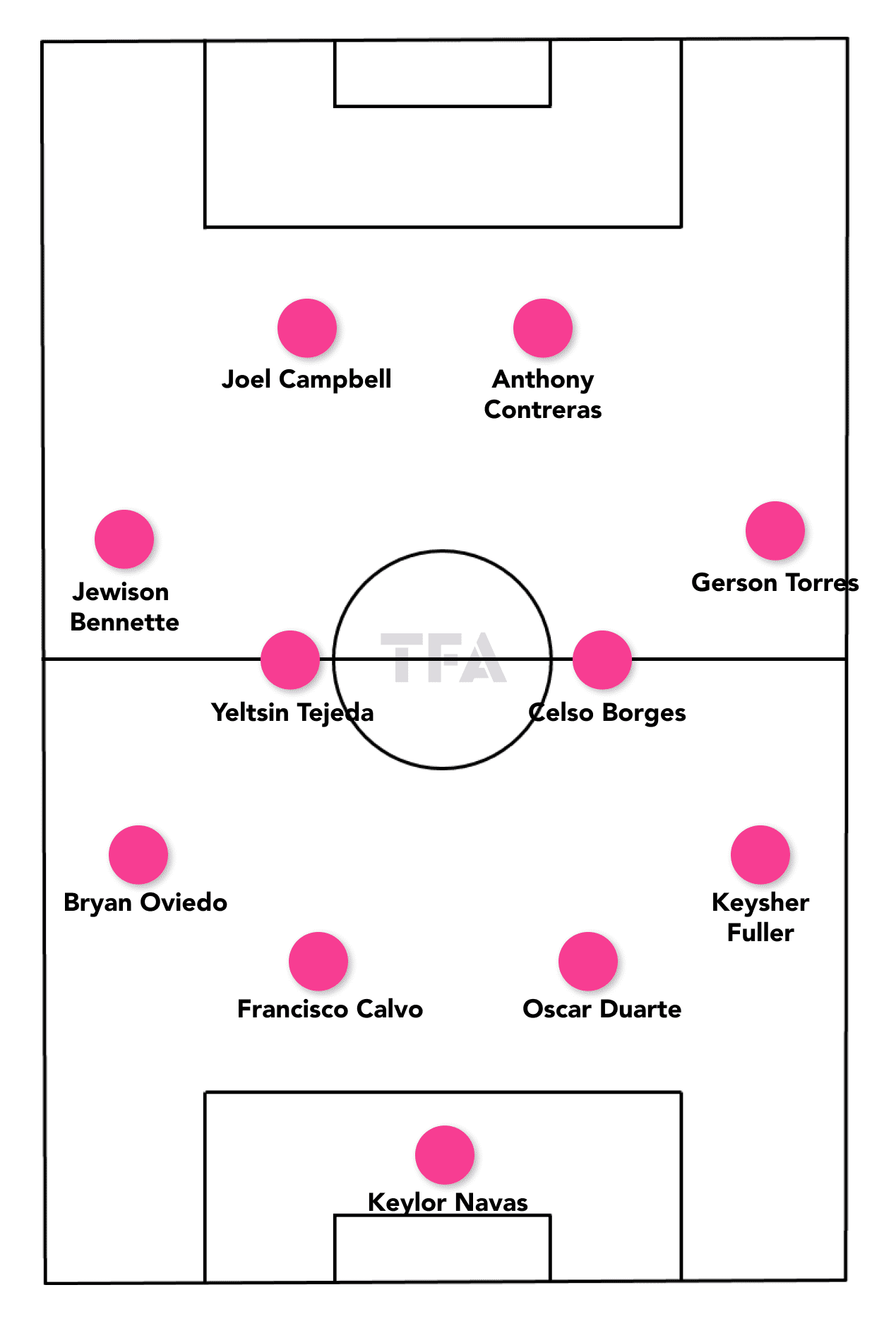
Costa Rica usually likes to play in a very wide 4-4-2 in possession of the ball; in this shape, the wingers offer great width and pace from the outside. Keylor Navas would be shielded by Francisco Calvo and Oscar Duarte in front, and Bryan Oviedo and Keysher Fuller in the full-back positions. Celso Borges and Yeltsin Tejeda form a double-pivot with Jewison Bennette and Gerson Torres on the wings. This set of players is joined by Joel Campbell and Anthony Contreras making up the forward line.
Costa Rica has started a great youth development project in recent years that has allowed them to produce players like Brandon Aguilera who can earn a transfer to the Premier League, as the attacking midfielder signed for Nottingham Forest from Alajuelense.
Players like Aaron Suárez, Anthony Contreras, Anthony Hernández or Jewison Bennette are some of the most underrated guns Luis Fernando Suárez could have at his disposal this winter. Although they are a very exciting and promising team, they also fill up their squad with lots of leaders and veteran players that keep performing well in the Costa Rican setup, such as Celso Borges or Johan Venegas.
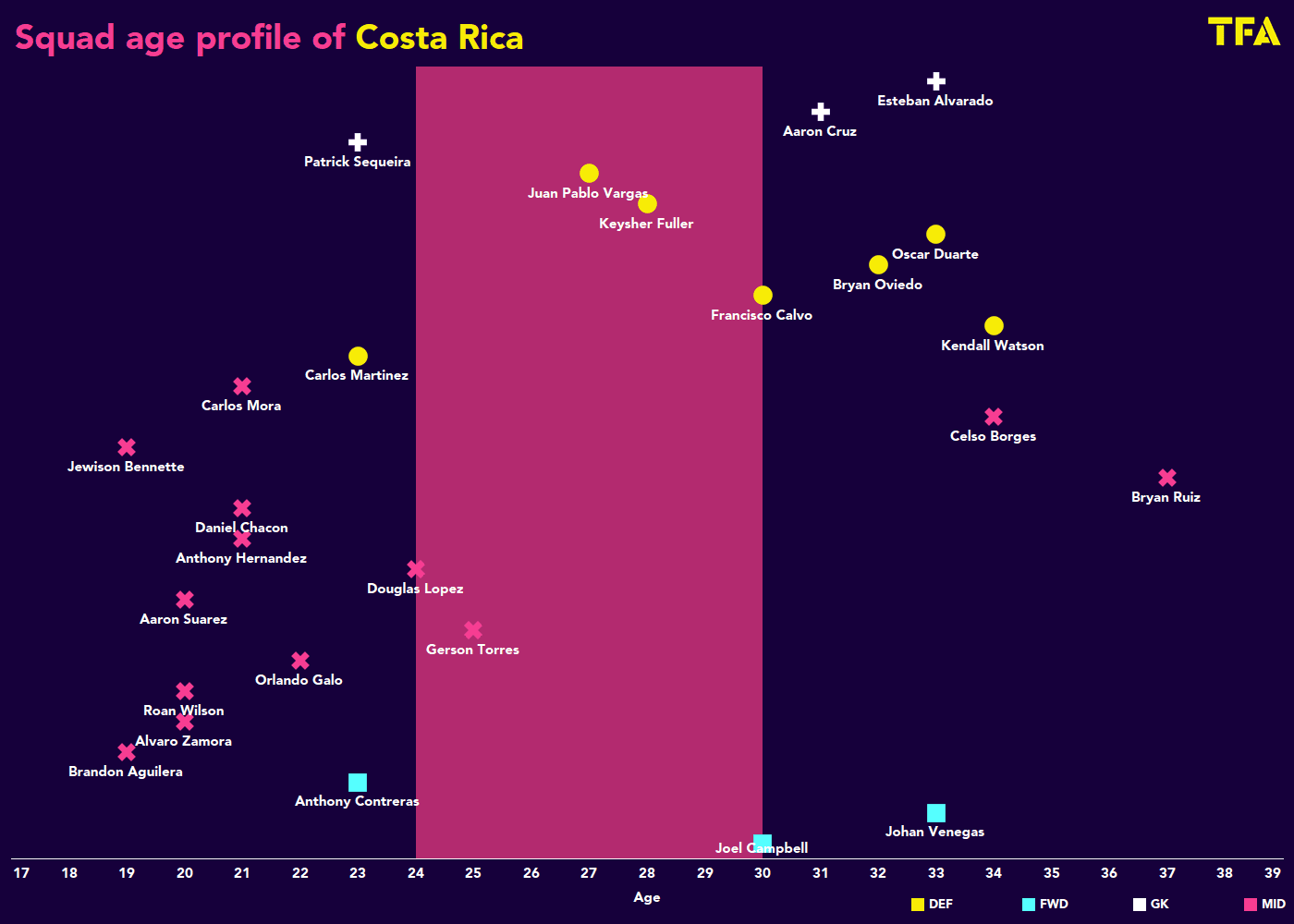
Attacking phase
In the data viz below us, we can see that Costa Rica likes to be an offensive and direct team with a high percentage of long passes and passes to the final third, in comparison to other teams we’ll see in action at the World Cup.
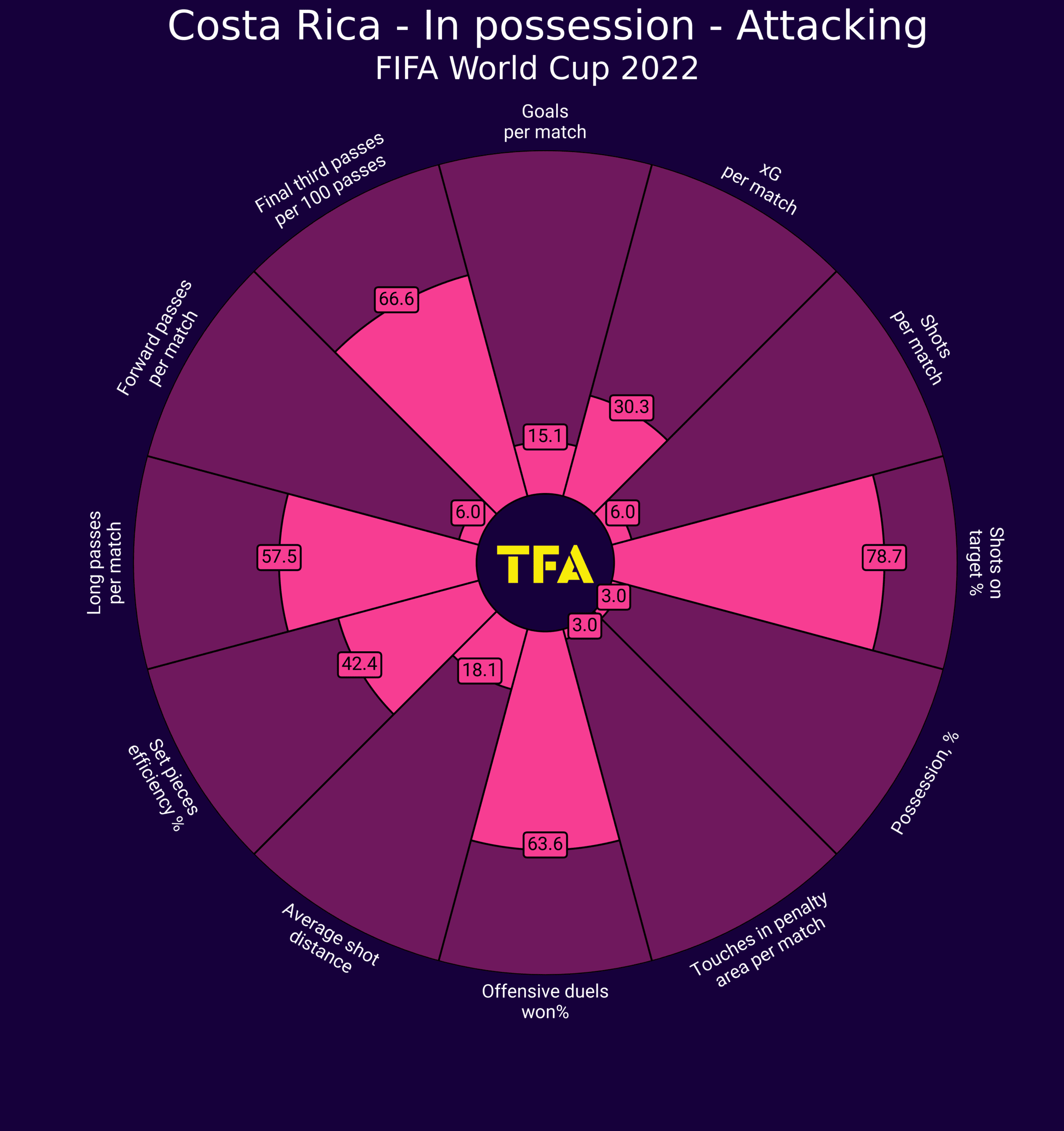
Costa Rica likes to go long to escape the pressure from deep, with the utilisation of Keylor Navas and his good long distribution to skip steps in the build-up and connect rapidly with wingers or full-backs out wide in the first phase. The example below shows us this direct intention to break lines quickly with long deliveries from deep, in this case being executed by the centre-back to the left-back.
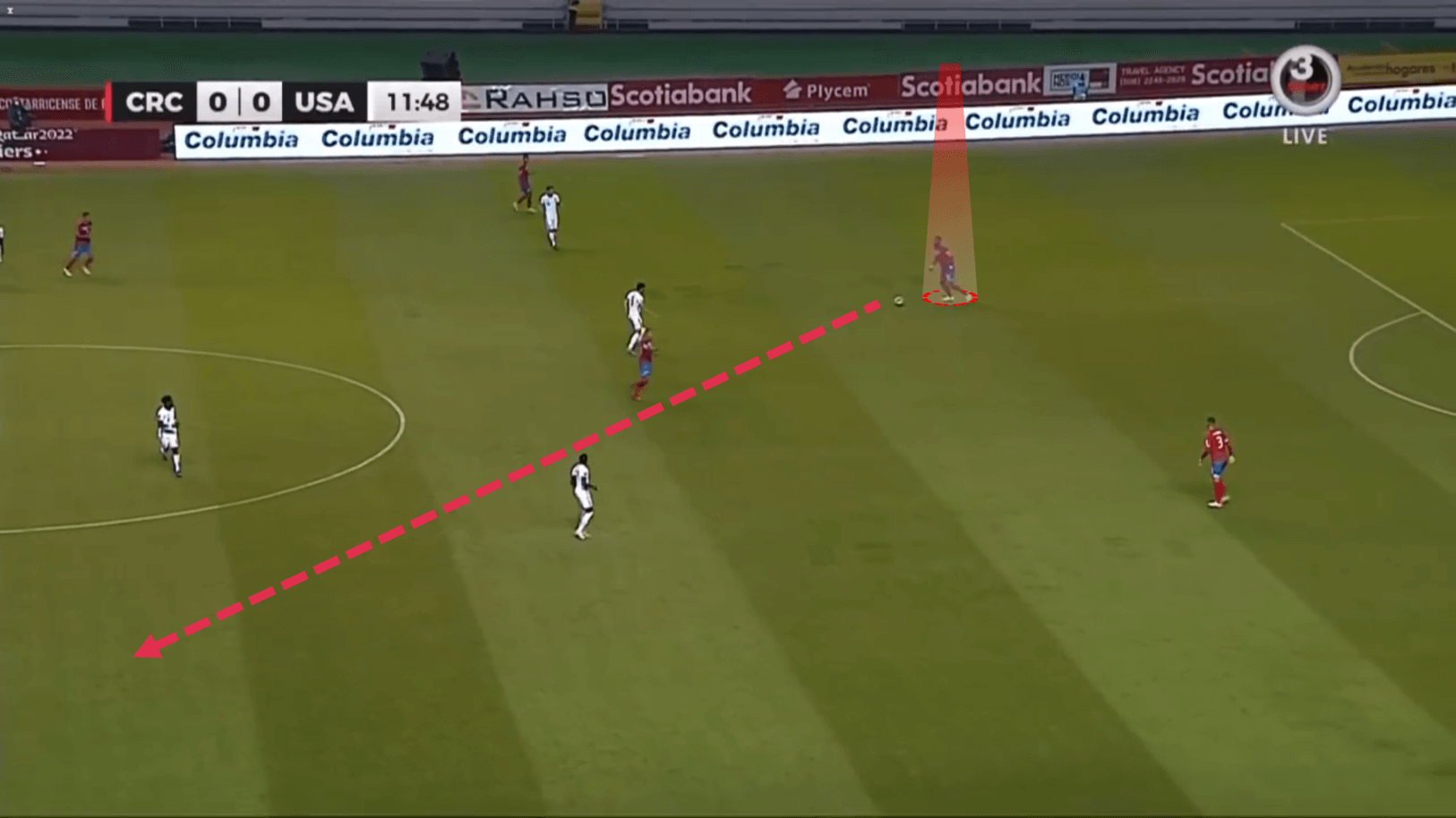
In the first stage of build-up, Costa Rica likes to give license to Keylor Navas to send long balls constantly, to start attacking transitions or to be moved quickly to the middle third, where the full-backs and wingers can play one-twos to progress the ball into the final third and create goalscoring opportunities. The figure below shows an example of the kind of pass frequently made by Keylor from the back.
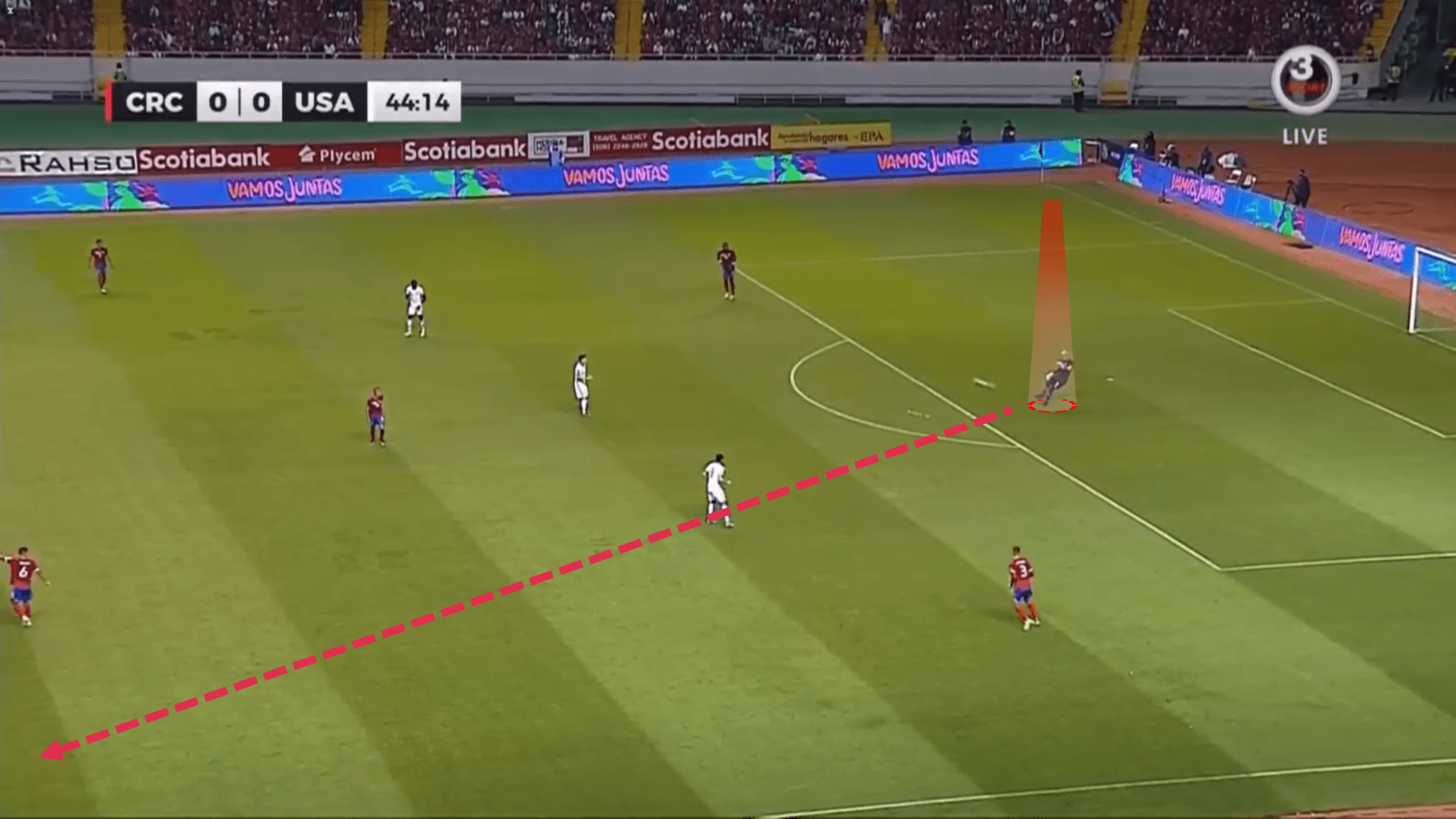
Again, the centre-backs show the ability to break lines and take responsibility for progression from the back, with good movements from the strikers who occasionally like to drop deep to give their deeper teammates options in the build-up phase.
The right-centre-back carries the ball this time through the middle and sees his forward, who has dropped very deep into their own third to receive the ball, showing for the ball. On receiving, the forward then turns to accelerate the team’s march on the opposition’s final third.
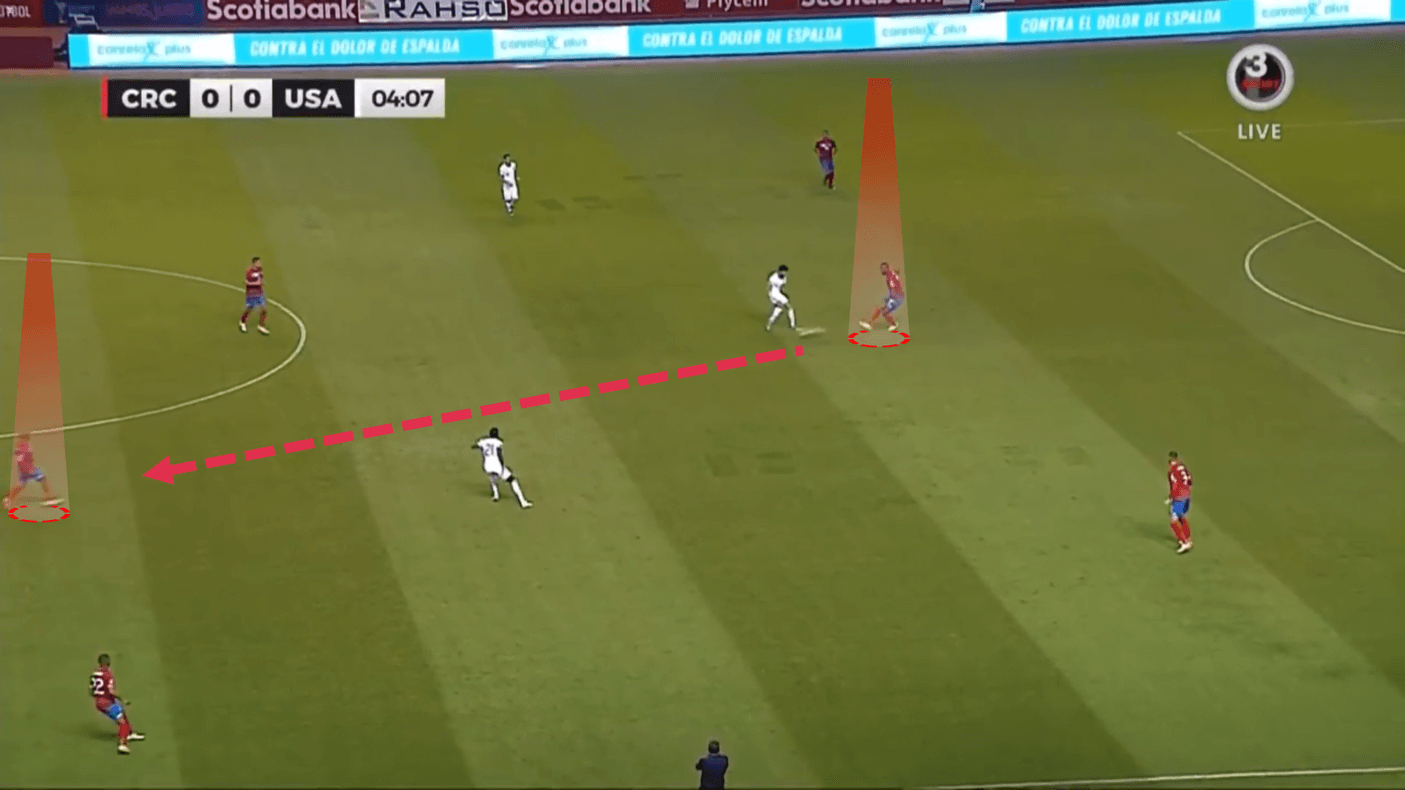
In the middle third, Costa Rica often create overloads out on the left-hand-side where the midfielder on this side joins to create numerical superiority, helping the left-winger and left-back to beat the pressure and escape with powerful runs and great dribbling ability to escape from small spaces. In this case, the left midfielder joins to be activated as a third man before his winger releases the ball to the full-back, who is then going to pass it to the middle where space has been created.
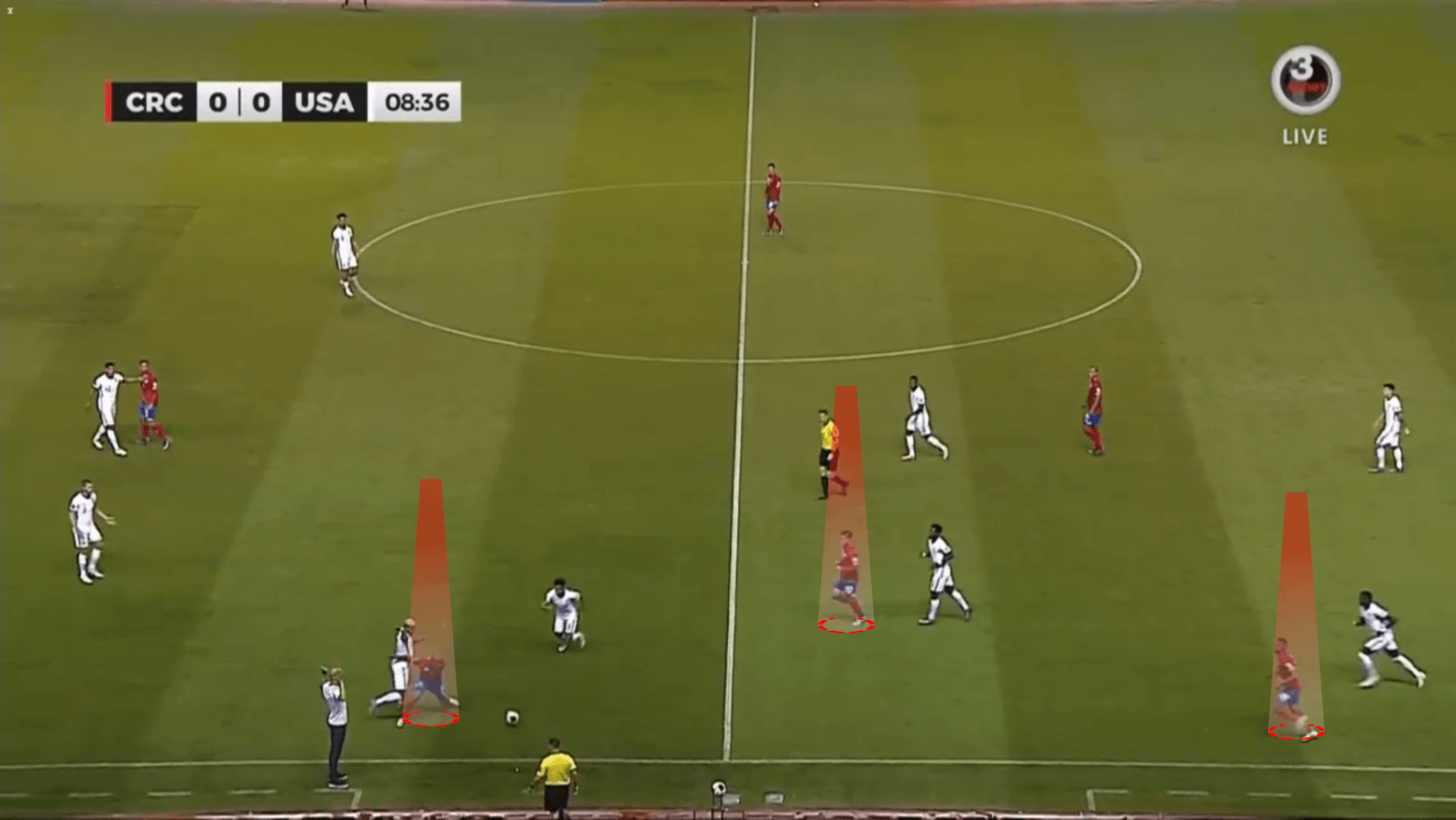
Costa Rica like to finish periods of possession with overlapping full-backs and aim to overload the box with players that can be a surprise factor to anticipate defenders and try to score headers. After they move the ball from wide to the middle, they change the ball immediately to the full-back on the weak side.
In this example, the right-back is the one to receive the ball with time and space to take a cross into the box, which is very congested thanks to the supporting runs of the midfielders and the two strikers who try to pin defenders.
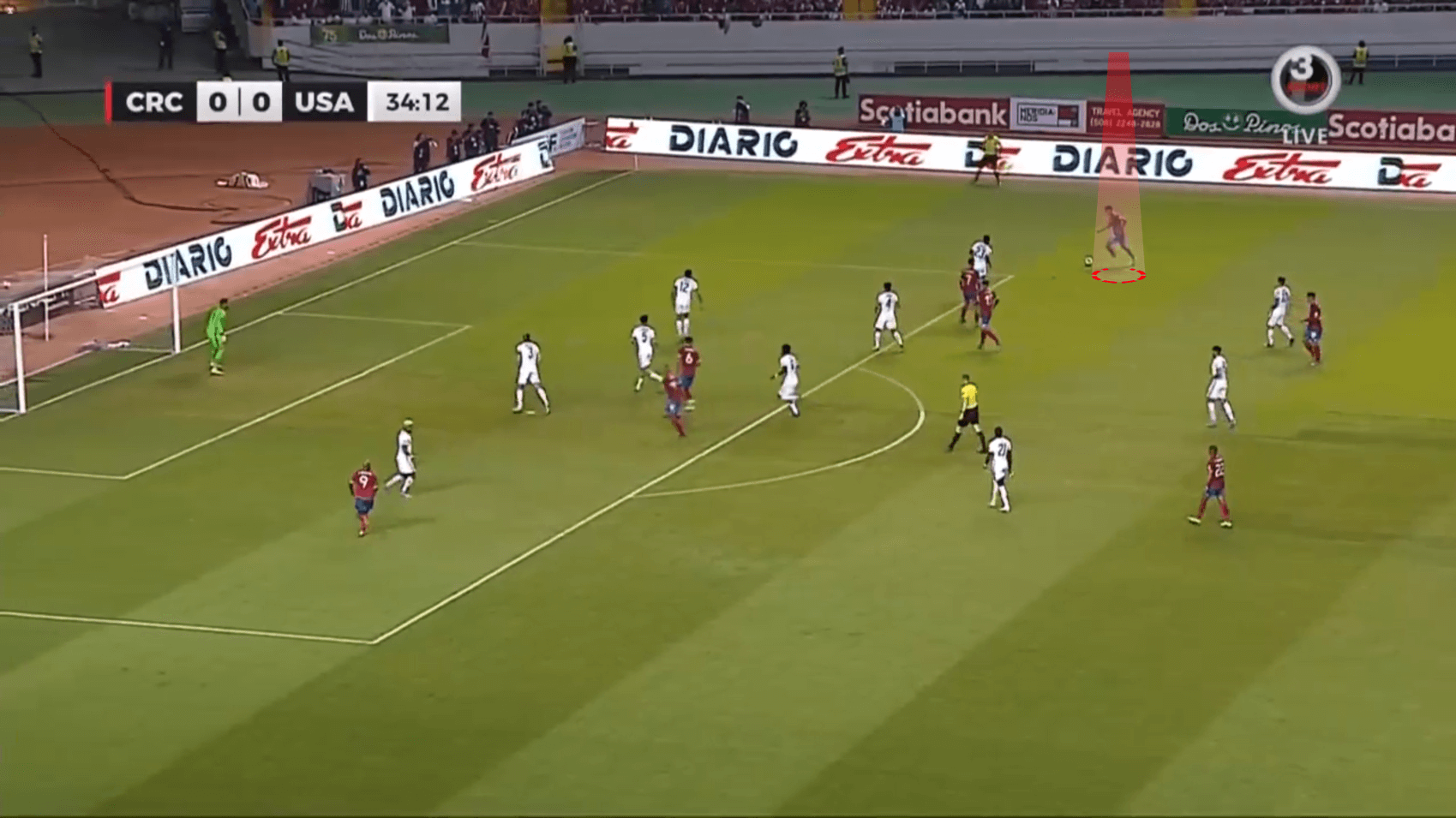
Defensive phase
The data viz below shows us some information about Costa Rica’s performance out of possession. Something worth noting when analysing this data is how Costa Rica like to apply little intensity versus the opposition high upfield when defending, as their PPDA is a very high one. Typically, they are a team that sustains a lot of pressure from the opposition out of possession and have to clear constantly and win the ball back several times in their own third.
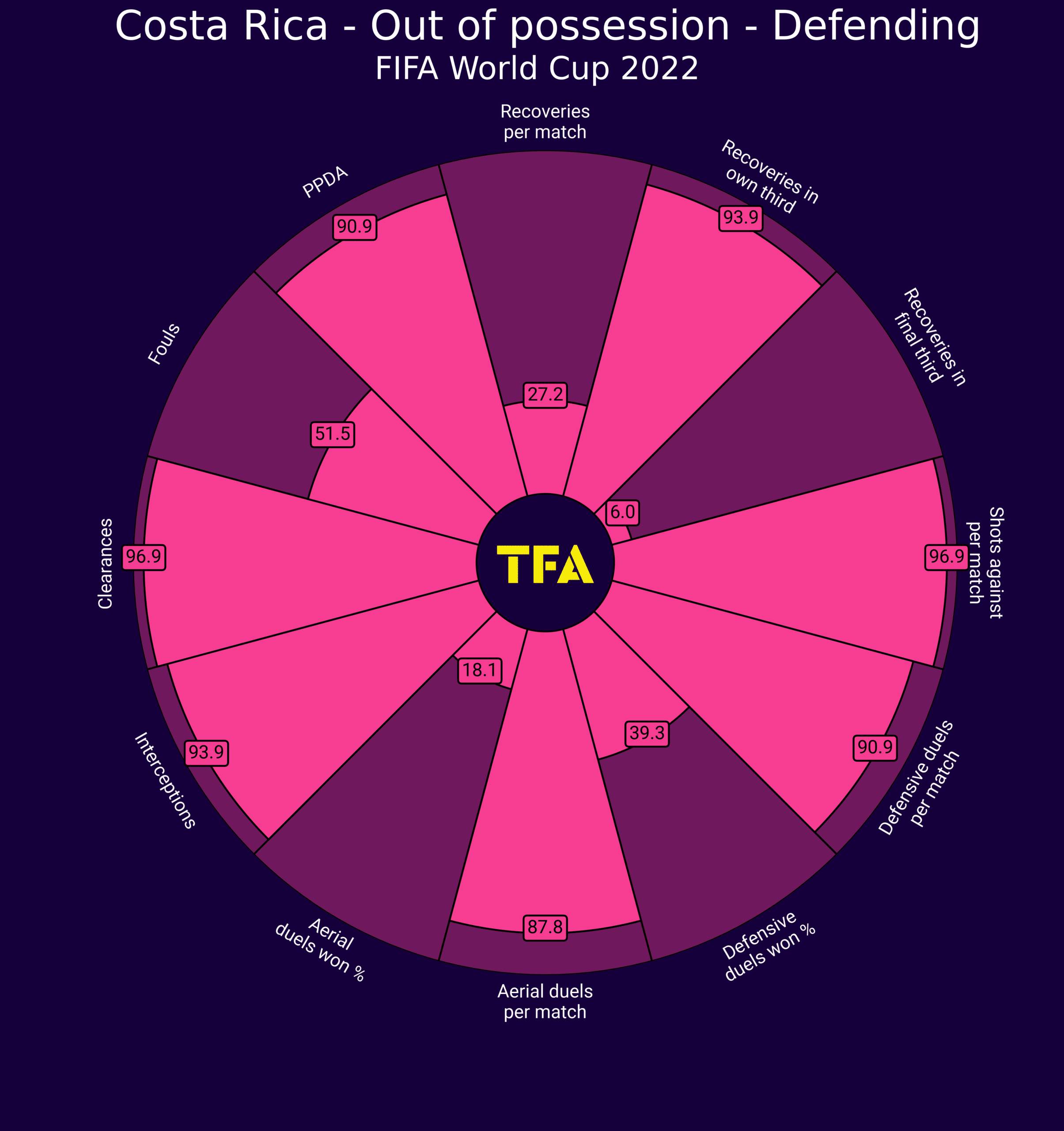
Luis Fernando Suárez’s teams like to defend in a narrow and rigid 4-4-2 position-oriented structure. In this system, the double-pivot tends to be a very proactive one to jump off their line and mark tightly rival midfielders. Both strikers perform the task of blocking passing options in front of the centre-backs, and the midfielders are required to mark zonally, protect this space, suffocate the opposition in central midfield positions and try to win the ball back via this rather passive approach.
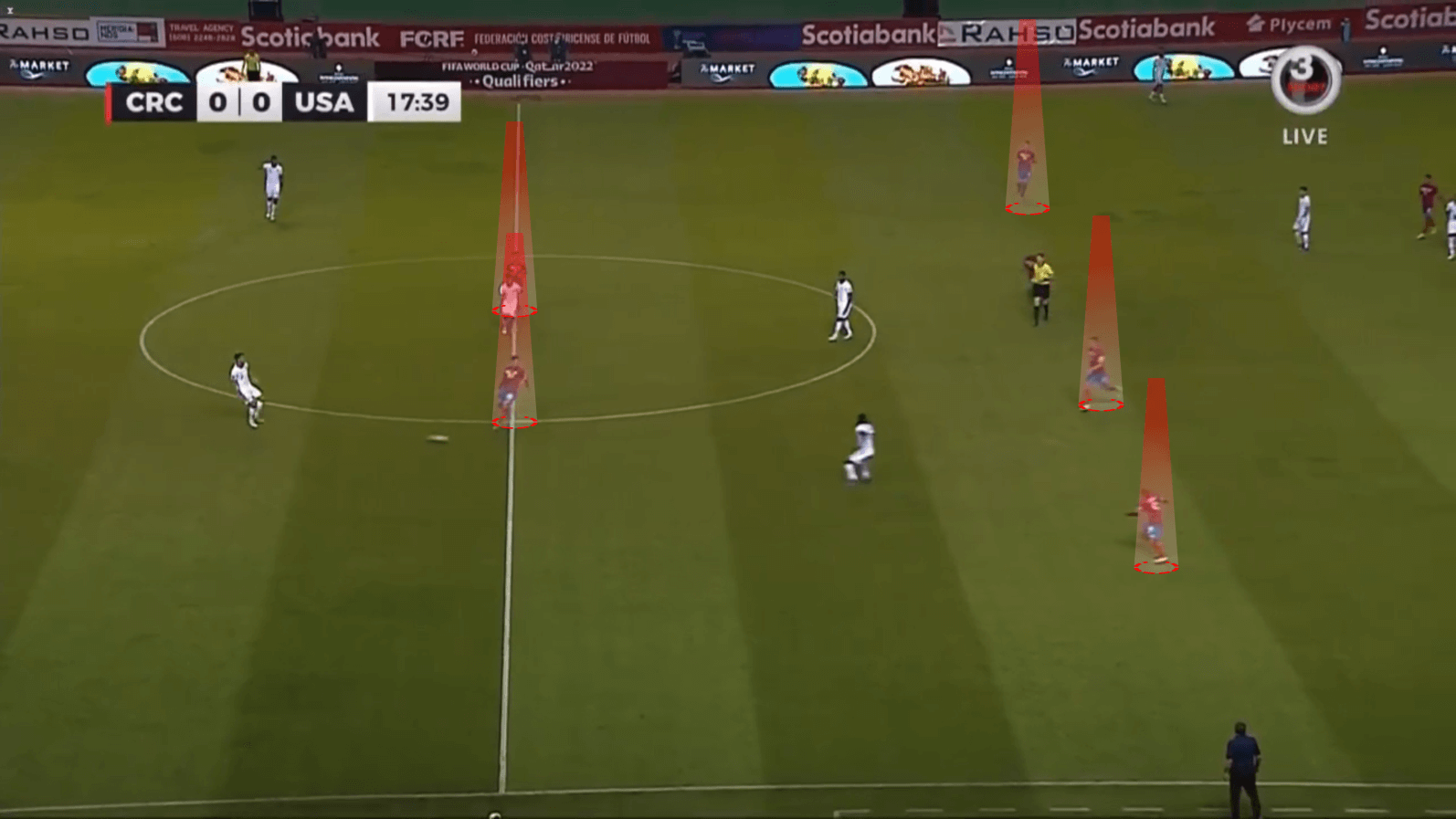
As we mentioned before in the defensive phase data viz, Costa Rica generally don’t press rivals very high on the pitch. However, they do on occasion, and it very much depends on the in-game situation at that moment, though we don’t expect to see them pressing with great intensity in Qatar very often.
They’ll try to accumulate plenty of players on the strong side of the ball to try and stress players, eliminating short passing options and forcing them to send long balls, thus ending the opposition’s possession phase by forcing them into a risky pass that gives Costa Rica’s deeper players a chance to regain possession. This example is a perfect visual of what we are explaining, as the six players of the midfield and forward lines mark very tightly in the final third of the pitch on this occasion.
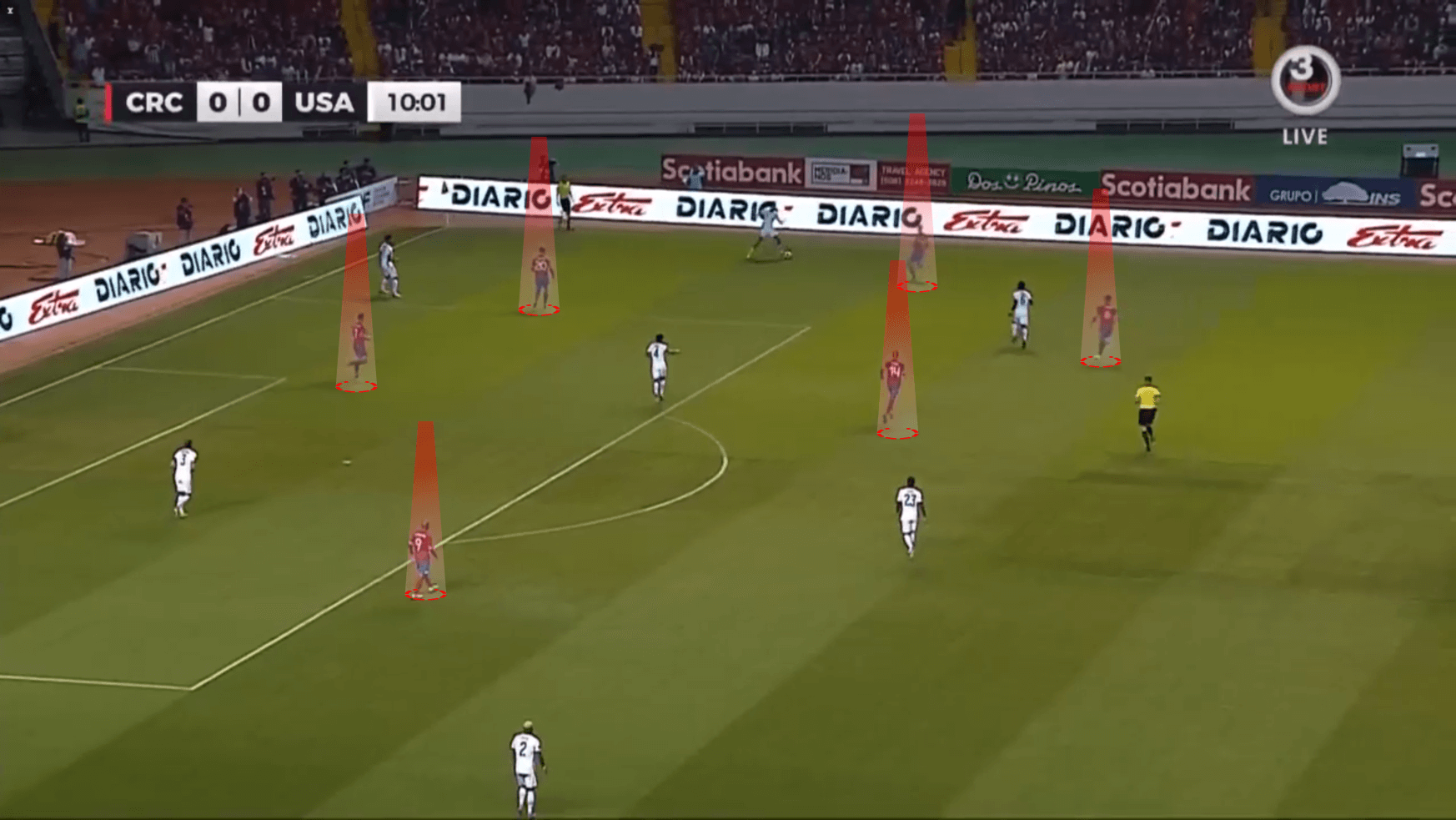
Transitions
In attacking transitions, Costa Rica like to rely on long passes from former Real Madrid keeper, Keylor Navas and the centre-backs to pacey Joel Campbell up front. The attacker has a brilliant synergy with Anthony Contreras, and their movements off the ball open spaces for each other and their other attacking teammates. Additionally, the wingers are frequently being activated to run to the box and take cut-back crosses.
In defensive transitions, Costa Rica have issues tracking runs from opposition players who can cause lots of harm with their runs, as their defensive line is not the fastest and can’t contain players at full speed, coming from the inside carrying the ball or defending through passes.
Defenders
Keylor Navas forms a big part of a defence full of players who will try everything to protect their line, with the likes of Francisco Calvo and Oscar Duarte in the centre-back partnership, inside Bryan Oviedo and Keysher Fuller as the starter full-backs. Carlos Martínez and Kendall Watson are other young players that could be primarily rotational parts of the team.
Midfielders
Yeltsin Tejeda and Celso Borges bring experience and leadership in the double-pivot, but players like Brandon Aguilera, Anthony Hernández or Orlando Galo can help the team with a lot of creativity and proactivity through the middle. Bryan Ruíz, Gerson Torres or Johan Venegas are the experienced attacking players but Jewison Bennette, at only 19 years of age, will surely be a tempting option for Suárez.
Attackers
Anthony Contreras has been really amazing and exciting for his country of late, he has already made his full debut, and we expect to see him lining up alongside his veteran partner Joel Campbell, who has continued to be a pacey and threatening option, pushing the last line of the defenders and making a nuisance of himself in-game.
Key player
Keylor Navas continues to be the most vital player in the Costa Rica national team, thanks to his clutch shot-stopping ability that helps his team to maintain clean sheets, as well as his contribution in the build-up, with the ability to make long deliveries to find free-men in width, to then open space through the middle.
As we can see in the example below, he has a high percentile considering prevented goals and save rate, as well as through passes — important areas of his game that Costa Rica will need to make the most of in Qatar if they are to progress in the tournament.
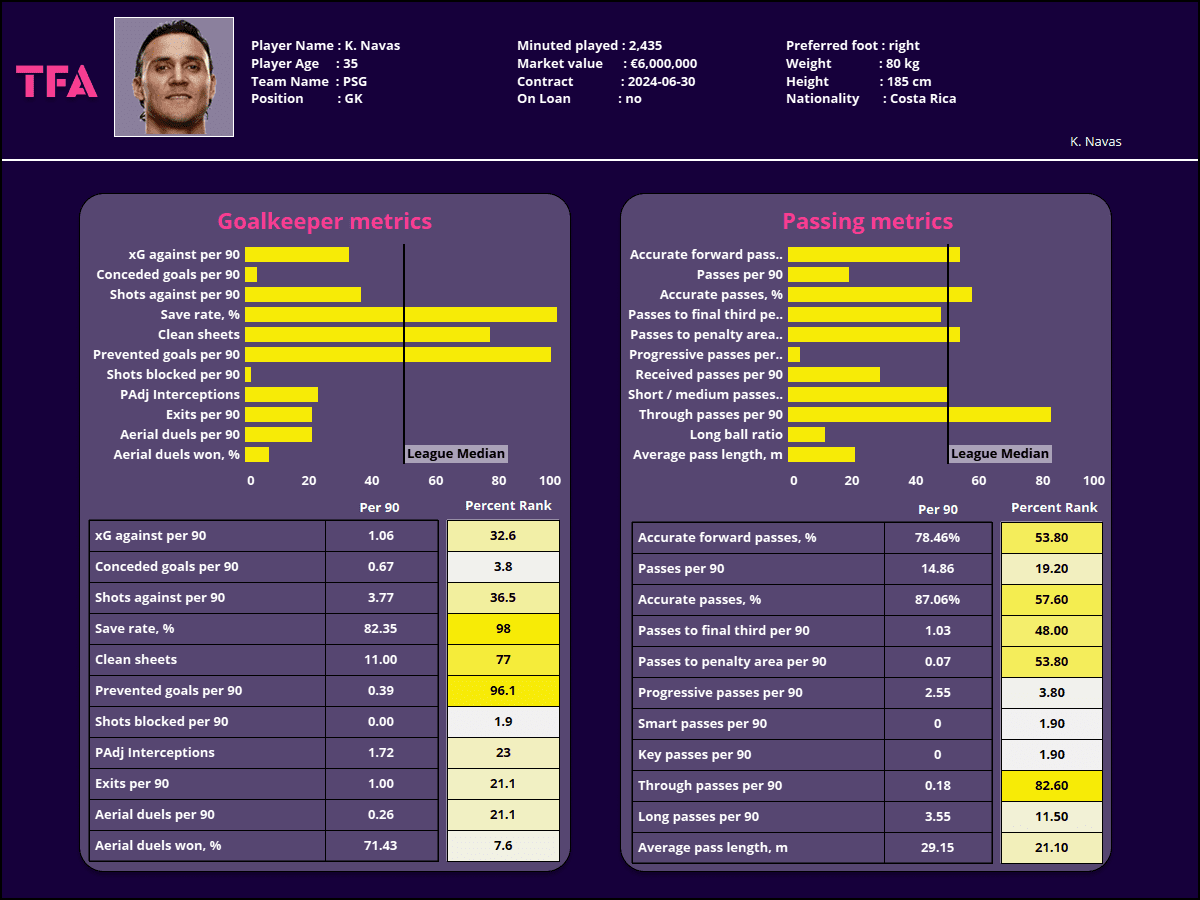
Tournament prediction
Costa Rica have a very balanced squad with legendary players for their nation occupying places in their team — such as Keylor Navas, Joel Campbell and Bryan Ruíz who remain truly vital for the side on and off the pitch.
However, players from the Costa Rican national league, like Contreras in the forward line or recent Nottingham Forest signing Brandon Aguilera excite the entire country in their bid to progress at least to a last-16 spot. This will be a tough ask for Costa Rica, who will have the odds stacked against them in the tournament and we struggle to see them progressing, given the strength of the other sides in their group, but, of course, they can’t be written off entirely.

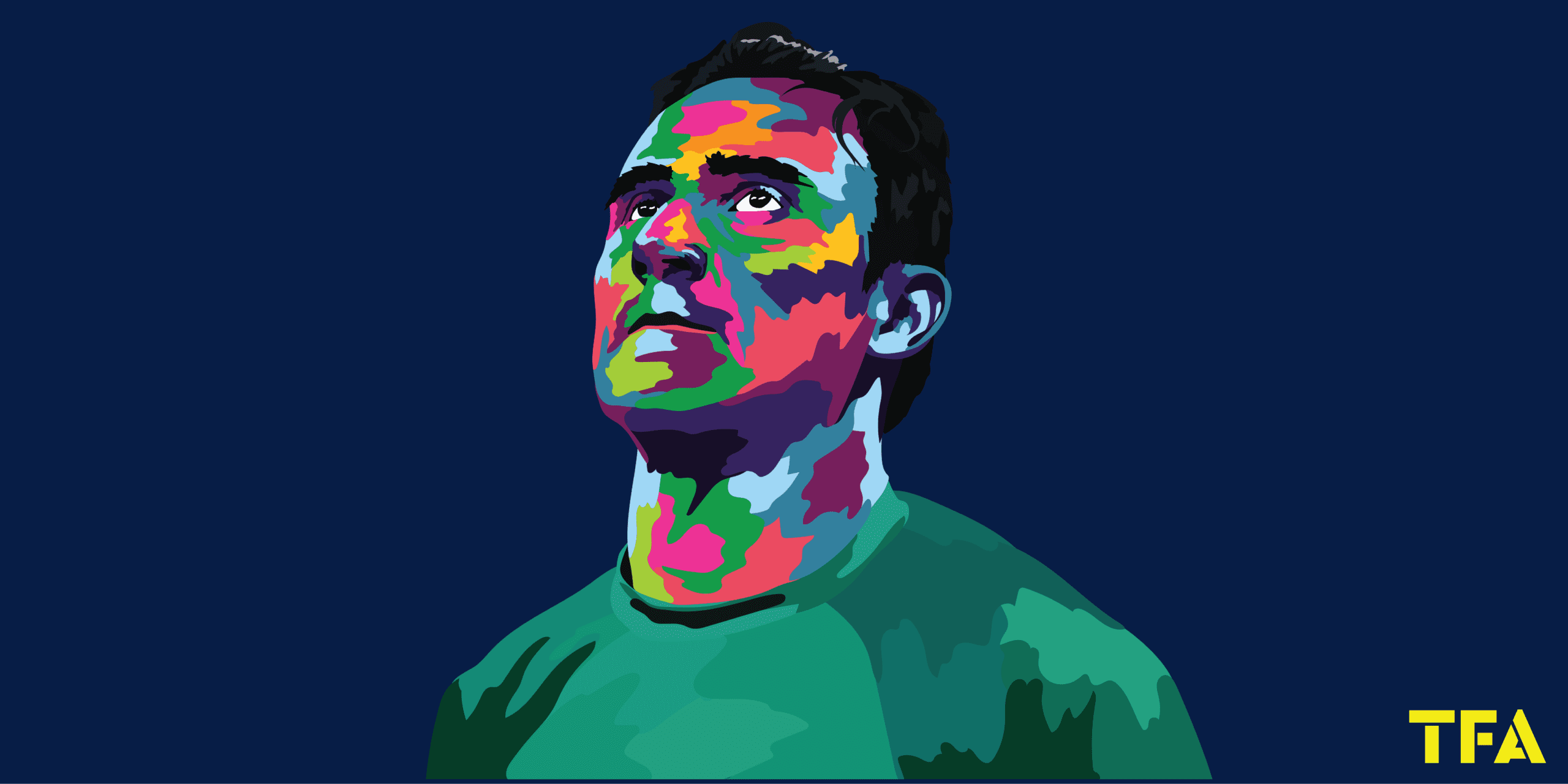




Comments